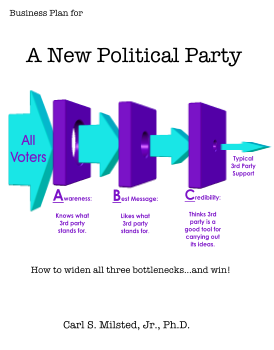Part 5: Starting a New Political Party from Scratch
Starting from scratch is hard, no doubt about it. Go to
politics1.com
and you can find a rather long list of stillborn political parties. And because getting off the ground is hard, credibility is lost, resulting in a Catch-22 situation.
On the other hand reforming an existing political party is also very hard. There are people who have been struggling within the Libertarian Party for well over a decade in order to get it focused on doing realistic politics. The honor roll of burnouts in this cause is large and includes the leading lights of the Cato Institute.
I have come to the tentative conclusion that launching a new party to take advantage of the upper-left market niche is easier than reforming an existing party. The Libertarian Party has too many anarchists and right-wingers. The Green Party has too many socialists. The Constitution Party is overly associated with the Right. The Reform Party is yesterdayís news. Anyone within these parties is more than welcome to prove me wrong.
And just what are the assets of the existing third parties? The Libertarian Party has name recognition, but this carries more negatives than positives. The LP has a donor list, but the national party has more monetary liabilities than assets last I checked. The LP has ballot access, but only wins elections in non partisan races, where such ballot access is irrelevant. The LP has a web site and a database, but so do I.
Opportunity cries out! Disgust with the existing major parties is high. The Internet, talk radio and cable television make for relatively cheap outreach. Electronic printing makes short press run outreach materials reasonable. Home computers have the power to mix quality video.
I submit that a small group of focused volunteers can do some of the jobs of running a political party better than the existing third parties. Other jobs can be postponed with few losses. As for the rest, thatís the tricky part. Can a party bootstrap from being tiny? Or must we first recruit some big donors and/or celebrities so we can jumpstart our new party? I donít know the definitive answer, but I can provide many clues, with tantalizing indications that bootstrapping from very little is possible.
A startup party has many challenges, including:
-
Acquiring members using limited resources. For example, getting new members using direct mail is not an option without substantial startup capital, since the near term return on investment is generally negative.
-
Being credible while small. A new party has no ballot access, professional staff, brand recognition or elected office holders. What can such a party offer besides blue sky promises?
-
Holding on to members. When a party is small, there is little to be lost by being smaller (i.e., a sunk cost). This provides little penalty for factionalism and schism. Keeping the organization together is a challenge.
-
Keeping overhead down. How far can we go without paid staff, offices, expensive conventions, newspapers, etc.? Which high-overhead items should we invest in first as we grow?
If we can manage to do good enough jobs with 1 and 3, then 2 and 4 take care of themselves to a large degree. But I am not going to count on doing so.
| 1 | 2
| 3
| 4
| 5
| 6
| 7
| 8
| 9
| 10
| 11
| Next
Copyright 2007, Carl S. Milsted, Jr. All rights reserved.
|
|






